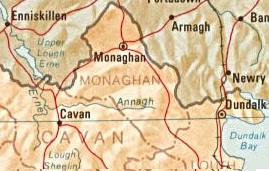
County
Monaghan
Lough
Major

In July of 1963, a strange animal with a "hairy head" and "two horns," was reportedly spied upon by three boys as it splashed about "like a sea-lion" in Lough Major. The boys, ages 18, 17 and 12, spotted the "monster" while returning from a fishing trip. They were at first startled by the peculiar spectacle but after regaining their composure, they responded its presence in a most juvenile manner. They threw rocks at the creature. The beast, apparently unamused by the barrage of missiles, advanced rapidly towards its assailants. The boys in turn fled in haste.

The 17 year old, Talbot Duffy, admitted to having shot plenty of otters and was positive the creature was not one. Upon returning the next day they discovered the dozen bream they'd abandoned during their retreat had been mysteriously devoured with only a few bones left on the ground. No doubt a form of retribution by the vengeful beast. Perhaps if these youth had the mindset to toss the fish instead of rocks, they'd of received a more encouraging reception.Adding some credence to the trio's unlikely story was a local man named Paddy Brady who claimed to have once seen the creature himself. The following weekend travelers from all over Monaghan and even neighboring counties arrived at Lough Major hoping to get a glimpse of the curious visitor. But to their disappointment the persecuted peiste seemed to have already left in search of friendlier territory.
|
|
COSTELLO, Peter In Search Of Lake Monsters [Berkley Medallion Books 1974] |
Major Walrus?Research colleague Gary Cunningham is quick to point out that the Lough Major beast fits very well with the description of a walrus. Certainly, the "splashing like a sea-loin" points towards a pinniped. The well whiskered muzzle might also appear as a "hairy head" from a distance. But the big make or break detail are the two "horns." While horns have been used to describe protruding bulges from the head in some reports, it's never certain if these objects are actual eyestalks or ears or otherwise. It should also be noted that it isn't unknown for journalists to distort a particular details, especially in such fringe matters so to make a story appear more intriguing. (Results of GUST's Lough Ree Expedition, for example, were well exaggerated by certain media outlets.) The "horns" may have been described as tusks but this would have been too much of a give away and defeated a more captivating article. Then again, it's hard to imagine the boys noticing the trademark tusks and not identifying it as a walrus. And further more, a walrus would have to first ford its way inland for 36 miles from the sea to get to the lake. Thus, if a walrus had been the culprit, it was a shame that this extremely rare occurrence wasn't properly documented.